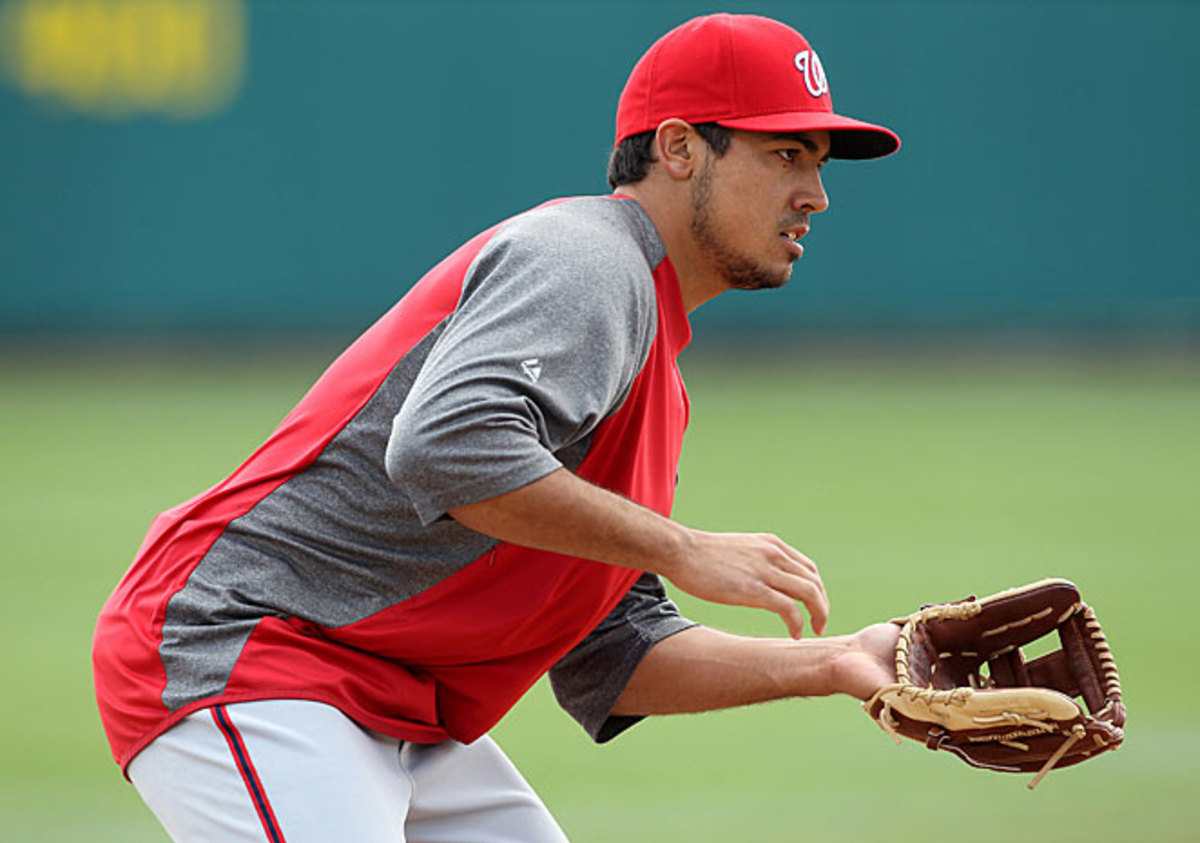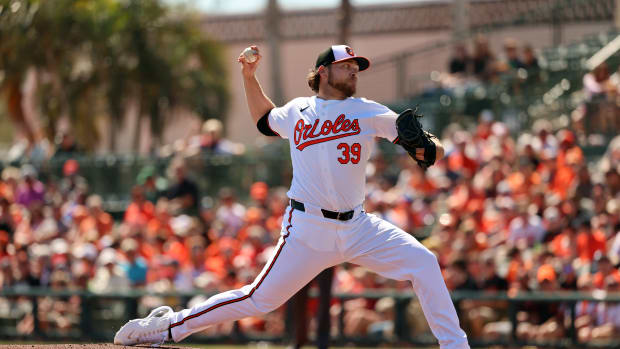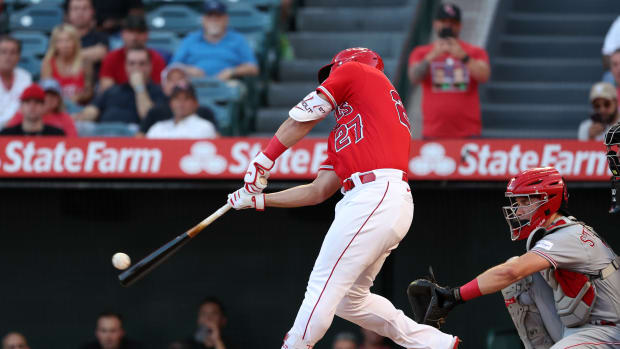NL East spring preview: Pitching questions for Nationals, Braves
This week, Cliff Corcoran will break down what to watch in each team's camp as part of SI.com's spring training preview. Teams are listed by their order of finish from 2012. Note: The Big Prospect is a player who will be in major league camp but has not yet debuted in the major leagues.
All spring training previews: AL East | AL Central | AL West | NL East | NL Central | NL West
Washington Nationals
The Big Question: How healthy is Dan Haren?
There's a lot of boom-or-bust potential in the one-year, $13 million contract the Nationals gave Haren to be their fourth starter behind Stephen Strasburg, Gio Gonzalez and Jordan Zimmermann. From 2005 to 2011, Haren posted a 3.49 ERA (122 ERA+) and 4.30 strikeout-to-walk ratio while averaging 34 starts and 226 innings per year, but all those innings may have caught up to him. Haren's velocity dipped below 89 miles per hour last year, the first of his career in which he was forced to the disabled list. He also posted an 87 ERA+ that was well-below league average, the result of a lot of hard contact that inflated both his hit and home run rates.
This offseason brought news that, in addition to the bad back that sent him to the DL last year, Haren also has a problematic hip, one that scared off both the Cubs and Red Sox early this offseason and has apparently been a chronic issue for him throughout his career. Haren thus far is on track and says he feels great, but we'll know a lot more about his condition at the end of the exhibition schedule.
The Big Battle: Catcher
The Nationals are apparently going to make Wilson Ramos fight to get his job back. Ramos had an impressive rookie season in 2011, hitting .267/.334/.445, strong numbers for a catcher (the average major league catcher hit .245.313/.389 that season), but a torn ACL last May wiped out the remainder of his 2012 campaign. Ramos is now healthy, but the Nationals were happy with the performance they got from Kurt Suzuki after an early August trade and plan to open the season with the two in some sort of job-share arrangement.
Ramos is the better option. At 25, he's four years younger and is under team control through 2016. Suzuki, meanwhile, has hit just .238/.295/.361 over the last three seasons, and while he's better defensively, Ramos has the tools to improve on that side of the ball. Suzuki would make an ideal backup for Ramos and shouldn't be taking at-bats away from him.
The Big Prospect: 3B Anthony Rendon
The sixth-overall pick in the 2011 draft, Rendon does everything well at the plate and in the field. The only thing he doesn't do well is run, and that's partially the result of the one red flag in his profile: injuries. Rendon, a Rice University product who turns 23 in June, raced up to Double-A in 2012, his first professional season, but before that happened, he missed nearly three and a half months with a fractured left ankle. In his final season at Rice, Rendon was slowed by injuries to his right ankle. That's alarming to be sure. Before the Nationals start to concern themselves with whether or not Rendon or Ryan Zimmerman needs to move off third base, they'll need to see Rendon make it through a full season standing up.
Atlanta Braves
The Big Question: How much will the pitching regress from the second half of last season?
The Braves went 52-29 (.642) over the last 81 games of the 2012 season, a performance that was fueled by some outstanding pitching performances. Kris Medlen led the charge by going 9-0 with a 0.93 ERA in 12 starts and nine relief appearances over that stretch, while Mike Minor (7-4, 2.21 ERA over his final 15 starts), Tim Hudson (10-3, 3.42 ERA), Paul Maholm (3.54 ERA in 11 starts after being acquired via trade) and Ben Sheets (3.47 ERA in nine starts) all contributed strong work. Collectively, those five men combined for a 2.65 ERA over 63 starts after July 4.
While they were doing that, closer Craig Kimbrel posted a 0.55 ERA and 18.2 K/9 over his final 33 appearances (he also converted 19 of 21 saves, with the Braves coming back to win in the two exceptions).
No matter how good those pitchers (minus the since-retired Sheets) are in 2013, they won't be nearly that dominant as a group, and Medlen and Minor are guaranteed to experience significant regression. The decrease in the quality of Atlanta's defense -- due primarily to the departures of Michael Bourn and Martin Prado -- could compound matters. The question is just how effective Medlen and Minor, especially, but also the aging Hudson, who will turn 38 around the All-Star break, can be despite that likely regression. Less doubt surrounds Kimbrel's ability to dominate the ninth inning and Maholm's likelihood of returning to his usual role as a league-average starter.
The Big Battle: Fifth starter
With Sheets retired, Tommy Hanson an Angel, Randall Delgado a Diamondback, Jair Jurrjens a non-tender on the verge of a major league contract with the Orioles and Brandon Beachy set to spend the first half of the coming season rehabbing from his June 2012 Tommy John surgery, the Braves suddenly find themselves a bit short on starting pitching. Then again, their top candidate for the last spot in the rotation is one of the elite pitching prospects in all of baseball.
Julio Teheran was Baseball America's fifth-best prospect coming into the 2011 and 2012 seasons and is still just 22. However, he had a dreadful 2012 campaign at Triple-A, seeing his strikeout rate drop for the second time in as many years to a pedestrian 6.7 K/9, and his home-run rate spike. He finished 7-9 with a 5.08 ERA and 1.44 WHIP.
Teheran has made four spot stars for the big club in the last two seasons, but not one of them was impressive in any way. He's the default choice for the final rotation spot, and none of his challengers are any more accomplished, but there's an argument to be made that Teheran could use more time in Triple-A to shake off that lousy season. If so, that could open the door for another top prospect such as lefty Sean Gilmartin or this man . . .
The Big Prospect: RHP J.R. Graham
A reliever at Santa Clara College, Graham was converted to starting after being drafted in 2011, and has since thrived in the role. He's listed at 6-foot-0 and 185 pounds, but his fastball sits in the upper 90s, he has an excellent curve and a developing changeup and he struck out nearly a man per inning in nine Double-A starts late last season. The Braves love him and it doesn't seem out of the question for the 23-year-old righty to force his way to the big club this year. The only significant concerns are about his size and the quality of that third pitch. Doubters think he'll end up back in the bullpen, but Atlanta will give him every chance to succeed as a starter.
Philadelphia Phillies
The Big Question: Can the veterans whose injuries undermined Philadelphia's 2012 season bounce back?
After a four-season run as the best pitcher in baseball, during which his average season saw him go 19-9 with a 2.59 ERA, 242 innings pitched, 213 strikeouts and nine complete games, Roy Halladay was limited to 156 1/3 innings and a 4.49 ERA, the second worst mark of his career, by shoulder and back problems last year. Meanwhile, Chase Utley and Ryan Howard didn't make their season debuts until late June and early July, respectively, due to knee and Achilles tendon injuries, ultimately combining for a .239/.333/.426 line in 654 plate appearances. Even still, the Phillies performed significantly better with those three on the active roster in the second half than they did without them in the first half.
Thus far this spring, all three are reportedly in good health and hoping to return to some version of their former greatness. Still, Halladay will be 36 in mid-May and has a ton of mileage on his right arm. Utley is 34 and has a degenerative condition in his knees that has sapped his power and limited him to 301 games over the last three seasons. Howard is 33 and has the skill-set, body type and late-blooming track record of a player likely to experience a significant decline in his mid-30s.
What's more, while the starting trio of Halladay, Cole Hamels and Cliff Lee still has the potential to be one of the best in baseball, the lineup around Utley and Howard has significant age and production issues. Jimmy Rollins is 34 and no longer a star-level player, new addition Michael Young is 36 and was two wins below replacement level for the Rangers last year, Carlos Ruiz is a 34-year-old catcher whose career year last year was interrupted by injury and will miss the first 25 games of the season due to an amphetamine suspension. New centerfielder Ben Revere has yet to homer in 1,064 major league plate appearances and the options in the corners are uninspiring.
The Big Battle: Outfield corners
Speaking of those outfield corners, when the Phillies signed Delmon Young in January, general manager Ruben Amaro Jr. said the former top overall draft pick would start in rightfield. He wasn't serious, was he? Young has hit .267/.299/.403 over the last two seasons and is one of the worst defensive outfielders in baseball. Young has cost his teams eight wins in the field over the course of his career per Defensive Runs Saved and arrives in Philadelphia having barely outplayed replacement level over his six-plus big-league seasons (0.6 bWAR).
Young would make some kind of sense as the righthanded part of a platoon (he has hit .307.341/.483 against lefties in his career, not counting some impressive work in the postseason) if not for that whole fielding thing. Lefty swinging Domonic Brown, who, to be fair, is no great shakes in the field either, might make a good platoon partner for Young, as might veteran journeyman Laynce Nix. The Phillies will also have righty sluggers John Mayberry Jr. and 26-year-old rookie Darin Ruf (nicknamed "Babe" Ruf in the minors due to his prodigious clouts, 38 of which left the park in Double-A last year) vying for playing time in the corners.
There's talent there, but Ruf, who is properly a first baseman, joins Young and Brown as less than ideal options in the field, and at 29, Mayberry is no longer on the upswing of his career. Whatever solution the Phillies settle on come Opening Day, it will be a compromise, and likely a temporary one at that.
The Big Prospect: LHP Adam Morgan
A third-round pick in the 2011 draft out of the University of Alabama, Morgan, who turns 23 at the end of the month, is a command-and-control lefty with a deep repertoire of good-to-above-average secondary pitches (slider, changeup, curve). He's not a future ace, but he cleared the jump to Double-A late last season, going 4-1 with a 3.53 ERA in six starts, which bodes well for his future. Scouts tend to be dismissive of pitchers with his profile, but Morgan is well-regarded, with many hanging a No. 3 starter tag on him and wondering if he might actually beat that projection if he can keep his fastball in the low-90s.
New York Mets
The Big Question: Is Travis d'Arnaud ready to open the season as the Mets' starting catcher?
D'Arnaud was the key piece New York acquired in the R.A. Dickey trade, so it's understandable if Mets fans, as well as many within the organization, want to see him contribute to the big club right away. Truth is, the 24-year-old d'Arnaud, who is the top catching prospect in the game and the sixth-best prospect at any position per MLB.com's Jonathan Mayo, is likely ready to do just that having hit .333/.380/.595 at Triple-A last year.
However, d'Arnaud put up that line in just 303 plate appearances as his season came to an early end due to a knee injury. That injury is likely the main reason (well, that and his arbitration clock) that the Mets want to see d'Arnaud spend a little time in Triple-A before they install him behind the plate in the majors. Still, doing so would make John Buck, who hit .213/.308/.358 over the last two seasons, the Opening Day starter, so d'Arnaud may be able to change their minds this spring.
The Big Battle: Outfield
On more than one occasion this offseason, Mets general manager Sandy Alderson has joked about his outfield for the coming season by saying, "What outfield?" Indeed, the Mets outfield was lacking last year and since then Scott Hairston, Andres Torres and Jason Bay have all landed with other teams while New York has struck out time and again in its attempts to fill the pastures, most recently losing out on Michael Born to the Indians.
Not counting non-roster Hail Marys like Corey Patterson and Marlon Byrd, the only outfielder the Mets have added to their 40-man roster this winter is former Arizona and Oakland reserve Collin Cowgill, a player who will turn 27 in May and has just 216 major league plate appearances to his name.
As things stand now, the righthanded Cowgill could wind up platooning in center with second-year lefty Kirk Nieuwenhuis. In left, the Mets will give 27-year-old slugger Lucas Duda, who is coming off wrist surgery, another chance in left (which manager Terry Collins said was a lock on Tuesday). In rightfield, expect some combination of Mike Baxter and pinch-hitting sensation Jordany Valdespin. After that, well, there's Byrd and Patterson.
The Big Prospect: RHP Zack Wheeler
Wheeler, the player acquired for the final two months of Carlos Beltran's contract in 2011, continues to climb prospect lists, coming in at eighth on Mayo's top-100 list this spring. Last year, at age 22, he made the leap to Double-A going 10-6 with a 3.26 ERA and more than a strikeout per inning, then finished the season with a comparable performance in six Triple-A starts.
The 6-foot-4 Wheeler, who was the sixth-overall pick in the 2009 draft, features an elite fastball/curveball combination backed up by an above-average slider and developing changeup and could emerge as a legitimate ace. That would give the Mets a devastating one-two punch in the rotation alongside fellow righty Matt Harvey as early as next year. Wheeler should get his first crack at the majors late in the coming season.
The Big Question: If Giancarlo Stanton is intentionally walked and no one is there to see it, does it count toward his on-base percentage?
Stanton hit 37 home runs last year and drove in just 86 runs. Of the 476 player seasons in which a hitter hit 37 or more homers, only twice did someone drive in fewer than 86 runs. In 1956, a 20-year-old Frank Robinson set the rookie record for home runs with 38 but spent most of the season batting second, led the league in times hit by a pitch, and drove in just 83 runs. In the strike year of 1994, Barry Bonds hit 37 home runs in 112 games but also led the league in walks, both intentional and otherwise, and drove in just 81.
Batting third behind 35-year-old Juan Pierre and 37-year-old Placido Polanco, look for Stanton to post a similarly incongruous home-run to RBI ratio in the coming season. With Justin Ruggiano and rookie catcher Robert Brantley among the top candidates to protect him in the Opening Day lineup given Logan Morrison's continued struggles to return from September knee surgery, look for Stanton to be among the league leaders in intentional passes as well.
The Big Battle: Fifth starter
With their roster stripped bare, the Marlins don't have a lot of options at most positions, but they have a few choices for fifth starter behind their intended front-four of Ricky Nolasco, Henderson Alvarez, Nathan Eovaldi and Jacob Turner. Those vying for the fifth spot include lefties Wade LeBlanc and Brad Hand, righties Alex Sanabia and Tom Koehler and non-roster righties Kevin Slowey, John Maine, Mitch Talbot and Doug Mathis.
That's not a particularly inspiring list, but there's at least some sort of depth there. Sanabia and Hand offer youth, Slowey and Maine offer experience and all eight have at least had some major league exposure in the past. Unless one of the non-roster arms has a revelatory spring, look for this one to come down to LeBlanc and Sanabia.
The Big Prospects: RHP Jose Fernandez and CF Christian Yelich
Law ranked Yelich sixth on his top-100 prospect list, while Fernandez ranked seventh on MLB.com's list. Both deserve mention here. The Cuban-born Fernandez was the 14th-overall pick in the 2011 draft and went 7-1 with a 1.96 ERA and more than a strikeout per inning at High-A in the second half of last season, a year in which he didn't turn 20 until the end of July. He has four average-or-better pitches with a high-90s fastball and curve that could both be elite complimented by a slider and changeup. Yelich, meanwhile, was the 23rd pick in the 2010 draft and hit .330/.404/.519 in 106 games at high-A last year at age 20. He may ultimately have to move into an outfield corner, but he should hit for average with on-base skills, 15-homer power, if not more, and 20 steals a year. Both could start the season in Double-A, earn a September call-up and be in the majors for good next year.




































